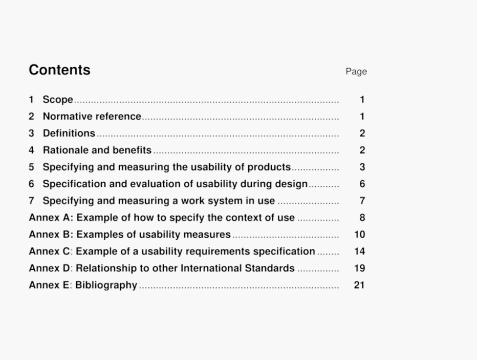ISO 09241-11 pdf download – Ergonomic requirements for office workwith visual display terminals (VDTs)一Part 11: Guidance on usability.
5.4.1 Choice of measures
It is normally necessary to provide at least one measure for each of effecliveness, efficiency and satisfaction.
Because the relative importance ci components of usability depends on the context of use and the purposes for
WtiICh usability is being descnbed, there is no general rule for how measures should be chosen or combined.
The choice of measures and the level of detail of each measure, is dependent on the o&ectives of the parties involved in the measuremenl The relative importance of each measure to the goals should be considered. For example where usage is infrequent, high importance may be given to measures of learning and reIearning
If it is not possible to obtain objective measures of effectiveness and efficiency, sub,ective measures based on the user’s perception can provide an indication of effectiveness and efficiency.
5.4.2 Effectiveness
Measures of effectiveness retale the goals or suogoals of the user to the accuracy and completeness win wnicn these goals can be achieved.
For example if the desired goal is to accurately reproduce a two-page document in a specified format, then accuracy could be specified or measured by the number of spelling mistakes and the number of deviations from the specified format, and completeness by the number of words of the document transcribed divided by the number of words in the source document
5.4.3 Efficiency
Measures of efficiency relate the level of effectiveness achieved to the expenditure of resources. Relevant resources can include mental or physical effort, time, materials or financial cost, For example. human efficiency could be measured as effectiveness divided by human effort, temporal efficiency as effectiveness divided by time, or economic efficiency as effectiveness divided by cost.
If the desired goal is to print copies of a report, then efficiency could be specified or measured by the number of usable copies of the report printed, divided by the resources spent on the task such as labour hours, process expense and materials consumed.
5.4.4 Satisfaction
Satisfaction measures the extent to which users are free lrom di5comforl, and their attitudes towards the use of I he product.
Satisfaction can be specified and measured by subjective rating on scales such as discomfort experienced, liking for the product. satisfaction with product use. or acceplabihity of the workload when carrying out different tasks, or the extent to which particular usability obectives Isuch as efficiency or learnabilityf have been met. Other measures of satisfaction might include the number of positive and negative comments recorded during use. Additional information can be obtained from longer-term measures such as rate of absenteeism, observation of overloading or underloading of the user’s cognitive or physical workload, or from health problem reports, or the frequency with which users request transfer to another job.
5.4.5 Further examples
Further examples of measures that can be used for assessing usability are included in Annexes B and C
5.5 Interpretation of measures
Care should be taken in generalizing the results of any measurement of usability to another context which may have significantly different types of users, tasks or environments, It measures of u5abillty are obtained over 5h0(t penods of time, Pie values may not take account of infrequent events which could have a significant impact on usability, for example intermittent system errors,
For a general-purpose product. it will generally be necessary to specify or measure usability in several different representative contexts, which will be a subset of the possible contexts and of the tasks which can be performed. There may be differences between usability in tnese contexts.
6.2 Specification of usability requirements for a product
Prior to development, an organisation seeking to acquire a product specifically adapted to ‘is needs can use the information in ISO 9241-11 as a framework for specifying the usability requirements which the product should meet and against which acceptance testing may be carried out Specific contexts in which usability is to be measured should be identified, measures of effectiveness. efficiency and satisfaction selecled. and acceptance critena based on these measures established fan example is given in Annex C).
6.3 Product development
The definition and framework for usability can be used by product development teams to establish a common understanding of the concept of usability, and can help product development teams addiess the breadth of issues associated with product usability.
ISO 09241-11 pdf download – Ergonomic requirements for office workwith visual display terminals (VDTs)一Part 11: Guidance on usability
